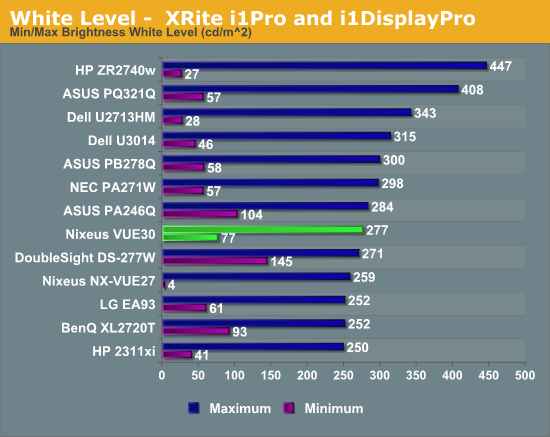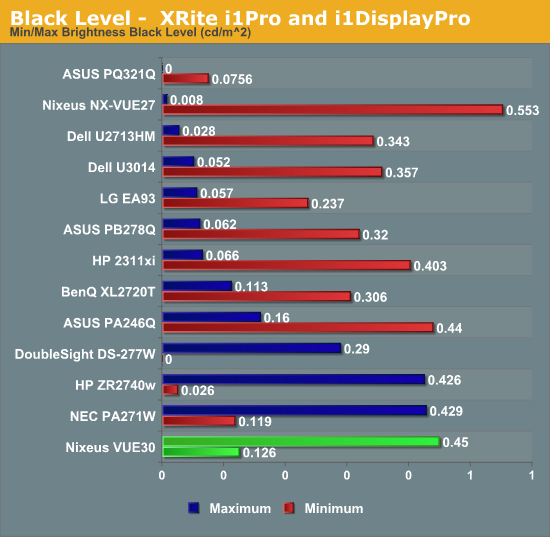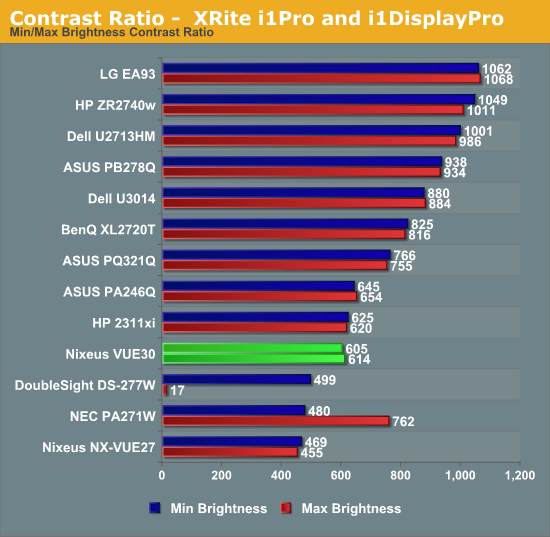Nixeus VUE 30: 30" 2560x1600 IPS Monitor Review
by Chris Heinonen on August 20, 2013 6:00 AM ESTIt seems that the larger the panel on a display I review, the brighter the display can get. I always expect the opposite, as lighting more screen would take more and more power. So far, that has not been the case. The VUE 30 is plenty bright, but not as blindingly bright as many other large displays. When I crank the brightness to maximum I measure 277 cd/m2 of brightness on a pure white screen. Moving the brightness to minimum drops this down to 77 cd/m2, which is below the 80 cd/m2 I like the minimum to fall under. This should provide plenty of range for most users.

With a black screen, we see a black level of 0.126 cd/m2 with the backlight at the minimum level. With the backlight to maximum this jumps up to 0.45 cd/m2. This level is very much in line with other computer monitors. I won’t fault Nixeus for this, but I’m always surprised at the level of black that is accepted with PC monitors that isn’t acceptable with TVs. Modern plasma displays can produce black levels of 0.006 cd/m2 under the same test conditions, and modern LCDs can hit 0.05 cd/m2 as well. I understand why plasma isn’t used for a PC display, but I’d like to see all vendors work on their black levels going forward. Basically, this panel seems similar to the 30" IPS displays we tested over five years ago; it's just half the price now.

These numbers provide us with a contrast ratio of just 610:1 on average. This falls well behind the Dell U3014 and ASUS PQ321Q displays, which are the most recently reviewed 30”+ displays I have data for. Those both cost a lot more, but being close to 600:1 is a disappointment to me.

With those basic measures out of the way, it was time to see how accurate the VUE 30 is.










95 Comments
View All Comments
cheinonen - Tuesday, August 20, 2013 - link
I'm finishing up a review of a 27" Monoprice display now that should run next week.blackoctagon - Thursday, August 22, 2013 - link
What about the overclockable 27-inch IPS screens, Chris? They can be sourced locally (from US) these days so no need to acquire one from Korea anymore. God knows there's been enough obsession about them during the past 12-18 months...and yet we still don't have truly professional reviews of themrepoman27 - Tuesday, August 20, 2013 - link
Can we please stop the silly trend of referring to all displays as [vertical resolution] & "p"? The resolutions and aspect ratios of computer displays are not governed by the ATSC or DVB, and none of these panels are intended to be driven in an interlaced mode. At best the "p" just sits there conveying no useful information, at worst it causes the writer to omit actually useful information.[horizontal resolution] & "x" & [vertical resolution] is better, and likely preferable to the rather forgettable initialisms such as "WQXGA". If you are talking about a display with an ATSC or DVB defined resolution and want to use the "p" nomenclature, at least include the maximum refresh rate, since this will definitely be a concern with the initial wave of UHDTV panels.
blackoctagon - Tuesday, August 20, 2013 - link
You're right of course, but typing 1440p is a lot quicker than 2560X1440. Not to mention the fact that pretty much everyone knows (or should know) what 1080p/1440p/1600p is shorthand for in the context of computer monitors.piroroadkill - Tuesday, August 20, 2013 - link
I agree.The p is totally hopeless information. Pointless trend. Even worse, when people have described 1920x1200 tablets as "1080p" or "Full HD". I don't want a 1920x1080 screen necessarily, but a 1920x1200 one is a more compelling ratio.
Impulses - Tuesday, August 20, 2013 - link
Alluding to the new Nexus 7 there? I had a chuckle when I saw Google use both terms on the official Play store page, right alongside the 1920x1200 listed res. It's like the average consumer can't even be counted on to remember more than one number anymore or even assume larger = better (probably why 4K has emerged as a label, anything more technically accurate would just go in one ear and out the other).DanNeely - Wednesday, August 21, 2013 - link
4k emerged as a term years ago in high end professional video circles because all but one of the resolutions used were 4096 pixels across; the aspect ratio was varied solely by changing the vertical resolution. From there it just trickled down; we geeks read about it on gadget blogs/etc and lusted after stuff that would support it while costing less than our homes and gradually popularized it as the next big thing. Meanwhile, and unsurprisingly the TV people settled on the slightly smaller quadHD standard since it has less implementation/back compatability issues.blackoctagon - Thursday, August 22, 2013 - link
I think you're being overly fussy. Even John Carmack casually uses the 'p' when describing the resolution of non-TV displays (just heard him do so on the QuakeCon keynote)7beauties - Tuesday, August 20, 2013 - link
Since this is an IPS panel, it probably goes without saying that its refresh rate is just 60Hz. The response time of 7ms is borderline if you're a gamer. What's most disappointing to me is that it has CCFL backlighting, making the display heavier, hotter, thicker, and less power efficient. Most current LCD's use the newer LED backlighting, so this is the LCD equivalent of paying luxury price for a car that's carburetered. I'll hold out for when OLED's take hold and become affordable. Thank you.DanNeely - Tuesday, August 20, 2013 - link
Except for the most expensive sort, LED backlighting cannot match a *good* CCFL for color gamut. While the lack of an sRGB mode limits the VUE 30 somewhat their backlight choice indicates they're going for the pro market where color accuracy is more important than the equivalent of an hours pay/year in extra power use or an increase in thickness that no one but a silly fanboi would care about.